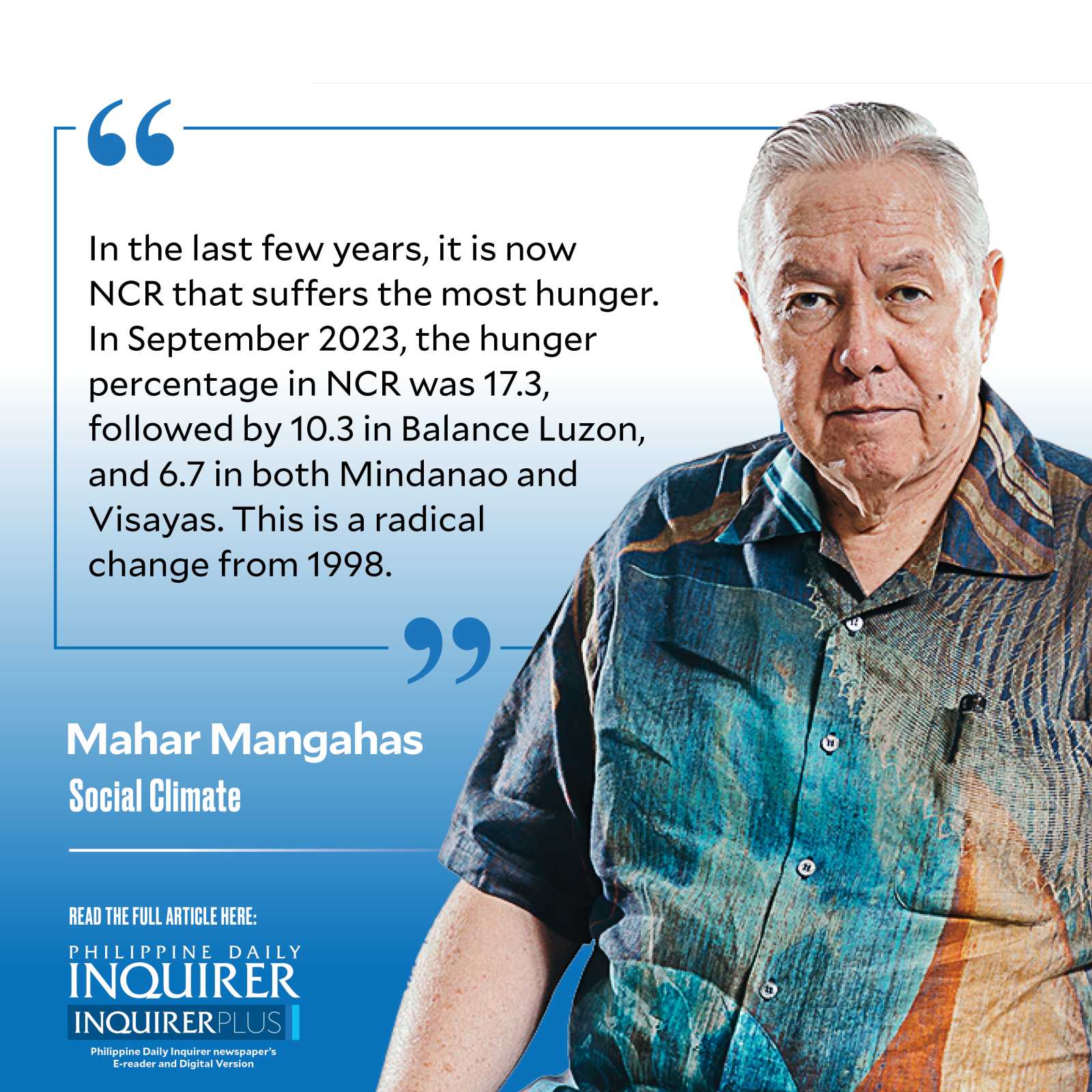Reading the hunger numbers

The new Social Weather Stations (SWS) proportions on hunger were released this week: “Third Quarter 2023 Social Weather Survey: Hunger falls from 10.4% in June 2023 to 9.8% in September 2023,” www.sws.org.ph, 11/20/23. Together with the 9.8 percent hunger in March 2023, the running hunger average is 10 percent in three survey rounds this year.
It was in July 1998 when, alerted by news reports of intense hunger in Mindanao, SWS first surveyed involuntary hunger—hunger suffered due to lack of food to eat (naranasan ng gutom at walang makain); not voluntary dieting as is done during Ramadan for example. The July 1998 survey found that 8.9 percent of families nationwide had experienced it in the past quarter.In 1998, hunger was indeed highest in Mindanao, at 15.3 percent. Next in the hungry percentage was Visayas (11.3). Hunger in the National Capital Region, NCR (6.1) and Balance Luzon (5.1) was single-digit. SWS maintained hunger as a survey topic thereafter and found it at 9.7 percent in September and then at 14.5 percent in November, for a double-digit 11 percent average in its 1998 surveys.
(Note that a steady proportion of hungry families still means a constantly growing number of the hungry, due to steady population growth. To estimate the absolute number of families affected by hunger, one may apply the SWS survey percentages to base numbers of the population, as periodically issued by the Philippine Statistical Authority (PSA). The base numbers of families used by SWS for mid-2023 [in millions] are: Philippines 27.439, NCR 3.724, Balance Luzon 12.367, Visayas 5.167, and Mindanao 6.182. The PSA does not report quarterly population numbers, as far as I know.)
Single-digit hunger has been very rare so far. In over 100 SWS surveys in the past 25 years, the annual average percentage hungry was in single digits only in 1999 (8.3), 2003 (7), and 2019 (9.3). It rose steadily from 11.8 to 19.9 in the eight-year period 2004-2012, and then eased down in the next seven years to 9.3 in 2019. For me, attaining single digits would mark a full recovery to pre-pandemic times.
Unfortunately, hunger exploded in the pandemic, reaching a catastrophic 30.7 percent in September 2020; it averaged 21.1 percent for the full year 2020 (see “Hunger is very stubborn,” 8/5/23). Thankfully it simmered down to 13.1 in 2021 and 11.7 in 2022. Whether it falls below 10 in 2023 depends on what the fourth quarter has in store.
Good health in the first 1,000 days of life, or ages 0-3, is crucial for developing the human brain. How many children in pandemic years 2020-22 suffered from undernutrition, and thus became permanently disabled in their mental capacity? Is there a way for these children to recover?
In the last few years, it is now NCR that suffers the most hunger. In September 2023, the hunger percentage in NCR was 17.3, followed by 10.3 in Balance Luzon, and 6.7 in both Mindanao and Visayas. This is a radical change from 1998.
NCR also had the highest hunger rate in the SWS survey areas in both 2022 and 2021. Families in densely-populated NCR are the most disadvantaged in terms of resources for growing or raising their own food. SWS has started monitoring home-production of food and will report on this sometime.
Severe hunger should be carefully watched. The September 2023 hunger rate consists of 8.4 percent moderately hungry and 1.3 percent severely hungry (which totals 9.8 percent, correctly rounded). “Moderate” means the family endured hunger only once or a few times in the last quarter; “severe” means it was often or always. Note that 1 percent equals 270,000 families nationwide.
In NCR, the 17.3 percent hunger consists of 13.3 percent moderate and 4 percent severe. In Balance Luzon, the 10.3 percent hunger consists of 9 percent moderate and 1.3 percent severe. Visayas has 5.7 percent moderate and 1 percent severe hunger. Mindanao has 6.7 percent moderate and roughly zero percent severe hunger.Moderation of food prices and equity in food distribution are crucial. The SWS quarterly data on hunger enabled Dr. Dennis Mapa, when he was still dean of the University of the Philippines School of Statistics (he presently heads the PSA), to estimate that a quarter’s spike in food prices would have an impact on the hunger rate for the next one to three quarters. This was in pre-pandemic times, using the hunger and cost of living data available then; how much is the impact of food prices on hunger now? What government agencies are doing the econometrics on this?
Food production does not get ramped up at a moment’s notice. A very effective way to alleviate hunger quickly is to remove tariffs and other restrictions on food imports. Another effective way is to directly distribute food in the poorest communities, as some nongovernmental organizations are doing.
—————-
Contact: mahar.mangahas@sws.org.ph.




















